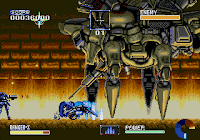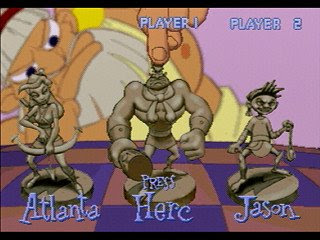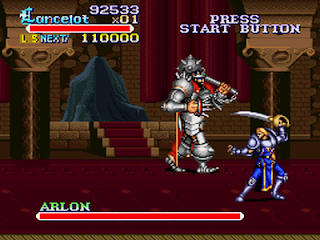 Growing up, I was a Genesis kid. Sure, the first system I had was an NES, but if you really pressed me for just one system that defined my childhood, the Sega would be it. And it may have been because at that time I began to be allowed to rent games. Almost every weekend began with my dad taking me down to Adventure Video, and as he was looking around for a movie to rent, I would stare in awe at the vast collection of games that seemed almost magical to my young mind. There was no set criteria for the games I would play. I rented randomly. More often than not, it'd be a last second grab as my dad was demanding we go home. So, it shouldn't be surprising that I've played a lot of games for the Genesis. That's why it's always a surprise when I run into one that I've never even heard of. And Ranger X, created by Toshio Toyota and Gau Entertainment in 1993, was one of those games.
Growing up, I was a Genesis kid. Sure, the first system I had was an NES, but if you really pressed me for just one system that defined my childhood, the Sega would be it. And it may have been because at that time I began to be allowed to rent games. Almost every weekend began with my dad taking me down to Adventure Video, and as he was looking around for a movie to rent, I would stare in awe at the vast collection of games that seemed almost magical to my young mind. There was no set criteria for the games I would play. I rented randomly. More often than not, it'd be a last second grab as my dad was demanding we go home. So, it shouldn't be surprising that I've played a lot of games for the Genesis. That's why it's always a surprise when I run into one that I've never even heard of. And Ranger X, created by Toshio Toyota and Gau Entertainment in 1993, was one of those games.The plot is a simple one. Those pesky terrorists have invaded the Homeworld, and it is up to you and your mech, Ranger X, to put a stop to them and restore peace to your planet. It's the kind of plot that's just there to placate the people like me that have to know what's going on and why they're blowing up everything that moves. It has no real effect on the storyline. Anything that the player needed to know, they knew before picking up the game. There are bad guys, and the player's the only one that can stop them.
The graphics are some of the best on the Genesis boasting detailed sprite work and top notch animation. The frame rate is mostly solid, but there are the occasional hiccup when there's too much on the screen. The locales that you visit are varied and interesting. Occasionally, the background's don't seem to shift with you, but in those cases the background is either an important visual or something that makes sense to be static.
Enemy designs range from generic orbs that fire missiles to small walking mechs with a shield that can only be attacked through careful movement and planning. The bosses in the game are huge, often dwarfing the Ranger X and making him look tiny in comparison. The fact the player's mech is several times the size of a person only add emphasis to how big these bosses are.
The game looks great, and there's no denying that, but having pretty graphics don't amount to much if the game doesn't play well. Luckily, Ranger X handles well. Attacking in this game is simple. A fires your gun left, C fires your gun to the right, and B fires which ever special weapon you have equipped at the time. If you happen to have a six button controller, you are able to also dictate how you wish your companion robot to shoot. The button setup for the game allows for almost the level of precision found in a schmup, because one is capable of training fire toward the enemy without having to break to dodge.
 Which is a nice touch, because this mech behaves more like a Gundam than a walking tank. Indeed, the Ranger X is a very flighty machine able to almost dart about the screen simply by pressing the direction you wish to go. In fact double tapping to the side or pressing down and then up, will launch the mech quickly across the screen. The maneuverability in this game is amazing. The only thing keeping you from dodging a shot is a bit of inertia and your own ability to guide your walking death machine out of harms way.
Which is a nice touch, because this mech behaves more like a Gundam than a walking tank. Indeed, the Ranger X is a very flighty machine able to almost dart about the screen simply by pressing the direction you wish to go. In fact double tapping to the side or pressing down and then up, will launch the mech quickly across the screen. The maneuverability in this game is amazing. The only thing keeping you from dodging a shot is a bit of inertia and your own ability to guide your walking death machine out of harms way.Unfortunately, these abilities aren't really put to the test that often in the game. Because, generally, a more methodical pace will serve you better, allowing the player to only face a few enemies at a time rather than a dozen. Of course, while you're inching along, you're probably riding in the Ex-Up, a motorcycle like mech that follows you through half of the levels. This is because not only does the Ex-Up have a different life bar than the Ranger X, but it also has an auto targeting system, which makes most of the situations in the game, especially early on, extremely easy. In fact, the first boss, with just a pinch luck, can be beaten by sitting in one spot and firing.
What I'm trying to get across is that the game is rarely frantic enough to force the player fully make use of the control scheme. This is why the third level is so enjoyable. In the third level, the Ex-Up is replaced by a hovering base that floats after you well above the action. Its only roles are the occasional blast of support fire and providing a place to swap your special attacks. So, the player no longer has the ex-ups extra life bar or its homing attack to fall back on when things get a little heated. And as this level is filled with little flying enemies, Ranger X will be darting around trying to dodge shots and enemies while keeping enough life that he can make it through the onslaught with enough health to destroy all of the targets. It's a moment that just feels right.
Speaking of the targets, the goal of each level is to destroy all of the targets in a given level. After which, the player will be whisked away to a boss battle. The issue I have with the targets is that a majority of the levels are just straight lines. The player walks, or climbs, in one direction, pausing to destroy the large enemy or base that they have been told to. But, a player would do that anyway. These are not just little houses that just sit there or tokens sitting slightly off to the side. These are enemies or bases that spawn enemies, which are sitting right in the player's path. Players would destroy them regardless of being told.
 It's not simply that there are targets that bothers me. Having targets makes sense in levels like two and five, which are large and sprawling. It actually forces exploration. However, in levels like one and four, which are literally straight lines, it ends up breaking the flow. And, I can't help but feel that those levels would have been better with only one target at the end and more quick, darting enemies to force the player to master controlling the mech.
It's not simply that there are targets that bothers me. Having targets makes sense in levels like two and five, which are large and sprawling. It actually forces exploration. However, in levels like one and four, which are literally straight lines, it ends up breaking the flow. And, I can't help but feel that those levels would have been better with only one target at the end and more quick, darting enemies to force the player to master controlling the mech.Unfortunately, there are actually very few times that being skilled at controlling the mech is required. Those few times are during the third level and at the final boss. Normally, one would think that the bosses would be the test that makes sure the player has gained enough skill, but that's not the case in this game. That's because Ranger X is more about the levels than the bosses, or rather, the bosses serve little more purpose than being a pothole on the road to the next level.
The bosses in Ranger X vary in difficulty from simple to easy. The first can be beaten, as I said, by sitting in the Ex-up and firing. The second is a little better, actually having four distinct parts and attack patterns that emerge as it loses health. The first two parts simply ask you to dodge back and forth and shoot. The third asks you to duck at the right time and shoot. While the fourth asks you to back up and shoot. Only the final boss and the second half of the third feels both fair and challenging.
This is in part because the game never forces the player to adapt beyond the first two specials: the Flame Unit and the Seeker Mine. That's probably because the Flame Unit, or flame thrower, is extremely powerful at close ranges, while the Seeker Unit, a grenade, is capable of destroying ground based targets in three hits. And as those are two of seven power-ups, it just feels like wasted potential.
The music in the game is good with quick and pumping beats that fit in well with a shooter, and do a good job of creating an environment of energy. The sound effects, on the other hand, are muted at best. The weapons sound weak and the explosions are muffled, which stands in contrast to how powerful the Ranger X actually is.

I've come across very harsh in this review, which wasn't my intention. Ranger X is a good game. It's just a good game that I feel could have been great if a few choices had been made differently. It's worth playing just for stage three alone. If you're a fan of mechs or just feel like playing a shooter with a unique playstyle, give Ranger X a try.














